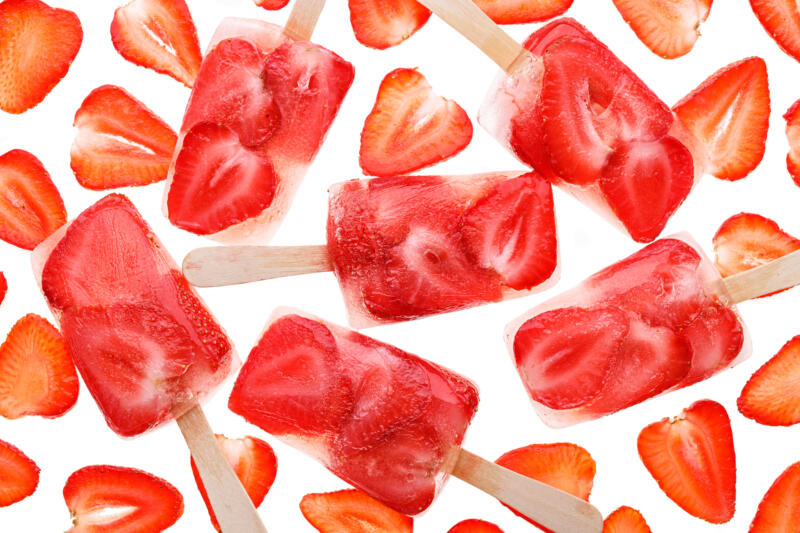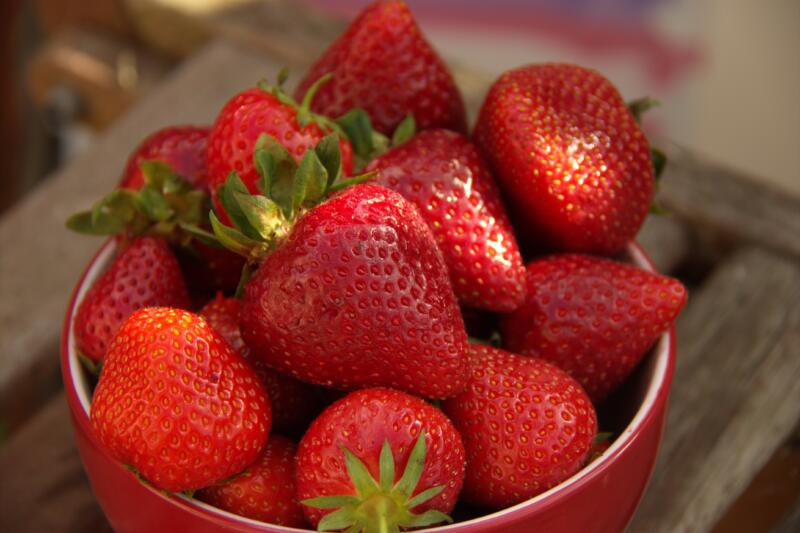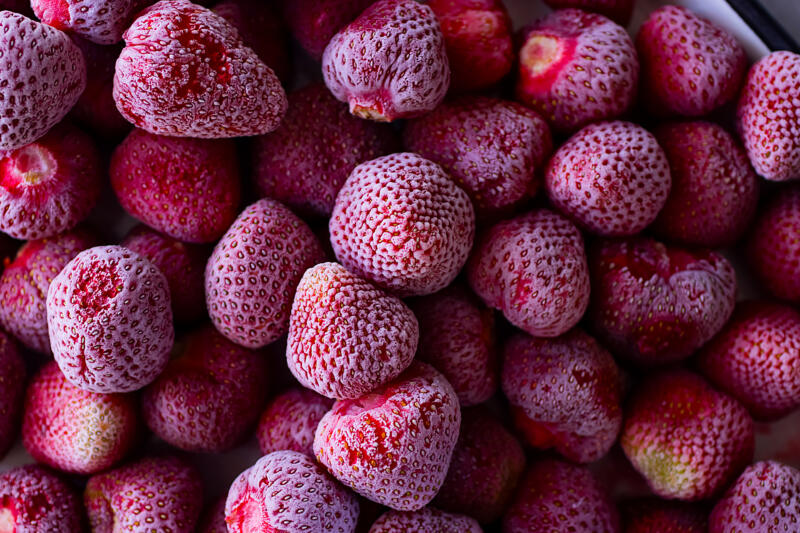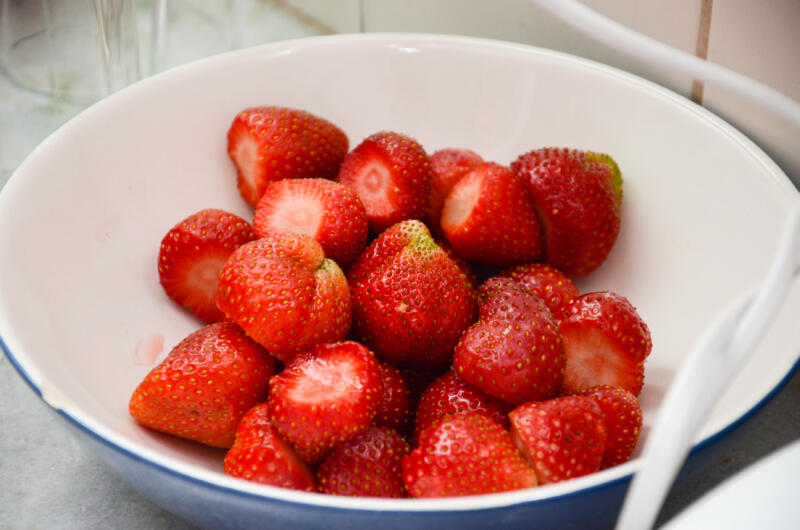Do you love to incorporate fresh strawberries into your recipes as much as I do? I’ve often found myself in a bit of a pickle when it comes to the shelf life of fresh fruits like strawberries.

I’ve learned the hard way that these sweet, juicy berries can go from perfectly ripe to moldy in what feels like the blink of an eye.
That’s why understanding the strawberries’ shelf life has become something of a necessity for me.
Highlights
- Proper Storage is Key: I found out that storing strawberries in the fridge in a container lined with paper towels can significantly extend their freshness. The paper towels absorb excess moisture, which helps prevent mold growth.
- Vinegar Bath Magic: Giving strawberries a quick vinegar bath before storing them is a game-changer. The vinegar solution helps kill off surface bacteria and mold spores, making the strawberries last longer.
- Freezing for Longevity: Freezing strawberries is a fantastic way to preserve their taste and nutritional value for months. Flash freezing them on a baking sheet before transferring them to a freezer bag ensures they don’t stick together, making it easy to use just the amount you need.
In this article:
What is the Shelf Life of Strawberries?

When it comes to the shelf life of strawberries, there’s a bit of a sweet spot.
Freshly picked strawberries typically stay fresh for about two to three days when stored at room temperature.
However, with the right storage methods, you can extend their freshness up to seven days or even longer.
The key to prolonging the shelf life of strawberries lies in how you store them.
Storing strawberries in the fridge can significantly extend their shelf life.
The ideal storage temperature for strawberries is around 32°F (0°C), which is just about the temperature of your refrigerator’s crisper drawer.
It’s best to keep them in a breathable container and not wash them until you’re ready to eat them, as moisture can speed up spoilage.
Please note that the actual shelf life can vary depending on the freshness of the strawberries when you bought them and the specific conditions of your fridge.
How to Identify Fresh and Bad Strawberries?
Knowing how to distinguish between fresh strawberries and bad strawberries can save you from a disappointing, mushy mouthful.
Fresh strawberries should feel solid, appear juicy, and display a radiant red shade.
They should be free of any dark spots, mold, or signs of decay.
On the other hand, bad strawberries may have a soft, watery texture and may display a white film on their surface.
Other signs of mold, discoloration, bruising, or a sour smell are clear indicators that your strawberries have seen better days and should be discarded.
Storing Fresh Strawberries

Let’s delve into specific methods for storing fresh strawberries to ensure they stay at their peak for as long as possible.
Original Container
If you’re planning to consume your strawberries within a day or two, storing them in their original container can be a convenient option. This method is simple and requires no extra preparation.
Just remember, do not cut or rinse your strawberries until you’re ready to eat them.
Cutting or rinsing them too early can introduce moisture, which speeds up the decay process and shortens their shelf life.
Airtight Containers
Airtight containers can be a strawberry’s best friend when it comes to extending their shelf life.
For whole strawberries, consider storing them in an open container lined with paper towels.
The paper towels will absorb any excess moisture, which can help prevent the growth of mold and keep your strawberries fresh for longer.
If you’ve already sliced or hulled your strawberries, an airtight container becomes even more crucial.
The container will prevent dehydration and bacterial growth, helping to maintain the quality and freshness of your strawberries.
Crisper Drawer
The crisper drawer of your refrigerator can be an ideal spot for storing fresh strawberries.
Strawberries prefer low temperatures of 32°F to 36°F (0-2°C) and high relative humidity, conditions that are typically found in the crisper drawer.
When storing strawberries in the crisper drawer, select a container with holes for ventilation. A shallow container is preferable as it allows for better airflow.
Arrange the berries in two layers to prevent them from getting squashed and to ensure even cooling.
Paper Towels and Plastic Wrap
Another effective method for storing fresh strawberries involves the use of paper towels and plastic wrap.
This method helps to absorb excess moisture and can significantly prolong the shelf life of the berries.
Begin this technique by laying a sheet of paper towels on the base of a container.
Add your strawberries, then place another layer of paper towels on top.
Finally, seal the container with plastic wrap. This will create a moisture-absorbing environment that keeps your strawberries fresh for longer.
Just remember, before you store them, ensure the strawberries are not soaking wet, as this can lead to quicker spoilage.
Storing Frozen Strawberries

While fresh strawberries are a delight, freezing them can be a great way to extend their shelf life and enjoy their sweet taste year-round.
Let’s explore some effective methods for freezing strawberries and how to identify when your frozen berries might have gone bad.
Freezing Unwashed Strawberries on a Baking Sheet
Freezing unwashed strawberries is a simple process that can help preserve their freshness.
Start by arranging the strawberries on a paper-lined baking sheet, making sure they’re not touching each other. This ensures they don’t freeze into a dreaded strawberry iceberg.
Then, put the baking sheet into the freezer and let the strawberries freeze completely over several hours.
Once frozen, transfer the strawberries into freezer bags for long-term storage.
This approach ensures you can snatch just the right amount without staging a “defrost the entire bag” drama.
Freezing Washed Strawberries on a Baking Sheet
If you prefer to wash your strawberries before freezing, the process is slightly different.
After washing, allow the berries to air dry before arranging them on a paper-lined sheet.
Like with the unwashed method, place the sheet in the freezer until the strawberries are fully frozen.
After a few hours, transfer the frozen strawberries to freezer bags for long-term storage.
Remember to squeeze out as much air as possible from the bags to prevent freezer burn.
How Long Do Frozen Berries Last?
The shelf life of frozen berries can vary depending on the storage conditions.
According to the U.S. Food and Drug Administration (FDA), frozen strawberries can be stored in the freezer for 8-12 months for best quality.
However, it’s important to note that while the quality might decrease after this period, the strawberries will still be safe to eat as long as they have been stored properly and there are no signs of spoilage.
Using freezer-safe containers or vacuum sealing can help maintain their quality and prevent freezer burn.
Signs of Spoiled Frozen Berries
Even frozen berries can spoil over time. Signs of spoiled frozen berries include the development of ice crystals, discoloration, and a mushy texture upon thawing.
Freezer burn, which appears as dry, white, or grayish spots, is another indication of spoilage.
Additionally, mold growth can occur on the berries, especially if they were not properly cleaned or dried before freezing.
If you notice any of these signs, it’s best to discard the berries to avoid any potential health risks.
Extending the Life of Strawberries

Strawberries are a delightful fruit, but their shelf life can be quite short if not properly cared for. Let’s explore some methods that can help prolong the freshness of your strawberries and ensure you get the most out of this delicious fruit.
Cleaning Unwashed Berries In Vinegar Solution
A great way to extend the life of your strawberries is by giving them a quick bath in a cold water and white vinegar solution.
To prepare the solution, mix 3 cups of chilled water with 1 cup of white vinegar.
Place your unwashed berries in the solution and let them soak for 5-20 minutes. This process helps to kill any bacteria and mold spores, extending the freshness of your strawberries.
After soaking, rinse them under cool running tap water to remove any vinegar residue.
Drying Berries
After their vinegar bath, it’s crucial to properly dry your strawberries. Excess moisture can lead to quicker spoilage, so using kitchen towels to pat them dry is a must.
Ensure they are completely dry before moving on to storage.
How to Revive Wilted Strawberries
If your strawberries have lost their firmness, don’t despair. You can revive wilted strawberries by immersing them in ice water for about 20 minutes.
This process can help restore their firmness and bring back some of their freshness.
Frequently Asked Questions about Strawberries

When it comes to strawberries, there are a few common questions that often come up. Let’s tackle some of them:
Can you eat strawberries that have gone soft?
While soft strawberries aren’t as pleasant to eat as their firm counterparts, they’re usually still safe to eat unless they show other signs of spoilage like mold or a sour smell.
How to tell if strawberries have gone bad?
Bad strawberries may be overly soft, have a white or grayish film, display signs of mold, or have a sour smell. If you notice any of these signs, it’s best to discard the strawberries.
Do strawberries go bad faster in the fridge?
Actually, the opposite is true. Storing strawberries in the fridge can significantly extend their shelf life compared to leaving them at room temperature.
Can you store strawberries in a Ziploc bag?
Yes, you can. However, it’s best to keep the bag slightly open to allow for some airflow or to use a bag with small holes.
Do strawberries go bad faster if you wash them?
If you wash strawberries and don’t dry them properly before storing, they can go bad faster due to the excess moisture.
It’s best to wash strawberries just before you’re ready to eat them.
Closing Thoughts
We’ve covered a lot of ground in this article, from understanding the shelf life of strawberries to learning how to properly store them for maximum freshness.
I hope this guide will help you enjoy fresh and delicious strawberries for a longer period.
Remember, a little bit of care can go a long way in extending the life of your strawberries.
If you have any questions or comments, or if you’d like to share your own tips, feel free to leave them below.